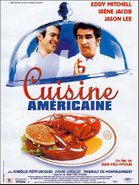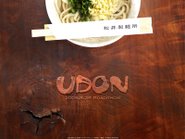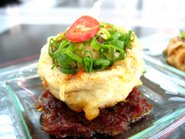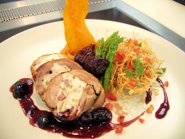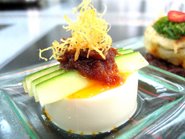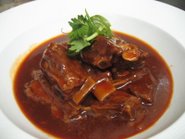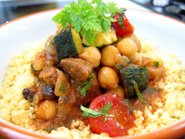Whampoa Club
4th Floor, Three on the Bund
Zhong San Dong Yi Lu
Shanghai, China
 One of the most heart wrenching things that is happening right now in Singapore are the exodus of good chefs that have chosen to leave this tiny red dot on the global map for greener pastures overseas. While we should be proud that our local chefs are making their mark overseas, what Singapore has lost is what the rest of the world especially China has gained. In the last ten years, we have lost prominent culinary talents like Justin Quek, the Aw Yong brothers, Jack and Martin, Eric Chiam, Jason Ong, Eric Ong, Jereme Leung, Kidd Leong, all which are home grown talents that have chosen to move beyond our shores. As the Chinese saying goes, “Bu shi Meng Long Bu Guo Jiang” or translated literally it means “only fierce and brave dragons will cross the mighty river”, the consolation is that we have people overseas whom we can be proud of as they showcase in their daily course of work, the mighty culinary prowess of this little island on the southernmost tip of continental Asia.
One of the most heart wrenching things that is happening right now in Singapore are the exodus of good chefs that have chosen to leave this tiny red dot on the global map for greener pastures overseas. While we should be proud that our local chefs are making their mark overseas, what Singapore has lost is what the rest of the world especially China has gained. In the last ten years, we have lost prominent culinary talents like Justin Quek, the Aw Yong brothers, Jack and Martin, Eric Chiam, Jason Ong, Eric Ong, Jereme Leung, Kidd Leong, all which are home grown talents that have chosen to move beyond our shores. As the Chinese saying goes, “Bu shi Meng Long Bu Guo Jiang” or translated literally it means “only fierce and brave dragons will cross the mighty river”, the consolation is that we have people overseas whom we can be proud of as they showcase in their daily course of work, the mighty culinary prowess of this little island on the southernmost tip of continental Asia.On our recent trip to Shanghai, N and I had the chance to catch up with what we have missed in the past, which is a chance to savour Chef Jereme Leung’s culinary talents. Before the opening of Whampoa Club in Shanghai, Chef Jereme Leung had been the Chinese Executive Chef of Jiang Nan Chun Restaurant @ the Four Seasons Hotel in Singapore. Whampoa Club is the talented chef’s first venture into China and has become a success story after three years. Along the way, Jereme has also published his first cookbook “New Shanghainese Cuisine”, a project which he spent a lot of time researching on the history of Shanghainese Cuisine and interacting with local chefs in this city of twenty million people. Whampoa Club’s menu is a platform to showcase a few of his collection of recipes from his research, creatively modernised and upgraded to a new theatre of taste and presentation. At the time of writing this blog, Chef Jereme was away in Beijing overseeing the opening of the second Whampoa Club. However with an able lieutenant in charge to execute the culinary visions of Chef Jereme, we were still in the good hands of Executive Chef Hew Choong Yew. For those of you who have started to scratch your heads on reading this, allow me to explain that it is not uncommon for many of these celebrity chefs to leave the running of their kitchens to well trained lieutenants as they start to zip around the world in exchanging the chef’s jacket and apron for a business suit and tie.
Dinner for us was booked a week ahead and my profession made known least the staff should start to get curious on why this particular diner has an interest to snap pictures of food only.
 Very kindly, we were given a table that allowed us to enjoy a panoramic view of the Bund as we dine.
Very kindly, we were given a table that allowed us to enjoy a panoramic view of the Bund as we dine.  The hairy crabs were in season and tasting menus featured dishes customised according to recent events like the hairy crab season, opening of the Beijing Whampoa Club and Formula One Grand Prix. I prefer to pick only two items from the hairy crab inspired menu and assembling the rest from the a la carte menu. As I scour through the menu, the amuse bouche arrived. It was a crispy cone of seafood and vegetables’ stuffing that was gone in two bites.
The hairy crabs were in season and tasting menus featured dishes customised according to recent events like the hairy crab season, opening of the Beijing Whampoa Club and Formula One Grand Prix. I prefer to pick only two items from the hairy crab inspired menu and assembling the rest from the a la carte menu. As I scour through the menu, the amuse bouche arrived. It was a crispy cone of seafood and vegetables’ stuffing that was gone in two bites.We started with a classic Shanghainese style Drunken Chicken. The name said so not because the bird was intoxicated with alcohol before slaughter but instead the gently poached free range poultry was drizzled with Yellow or Shaoxing wine before being served. It is served cold as an appetizer dish in many classic Shanghainese restaurants.
 Here at the Whampoa Club, Chef Jereme has given this classic dish a modern twist which should just aptly rename the dish as Drunken Chicken with Shaoxing Wine Granita. Using the idea of
Here at the Whampoa Club, Chef Jereme has given this classic dish a modern twist which should just aptly rename the dish as Drunken Chicken with Shaoxing Wine Granita. Using the idea of  shaved ice desserts that is popular in South East Asia, the chef puts a combination of seasoning sauces and the fragrant wine together. It is then frozen into a block and shaved over the deboned chicken. As the ice melts, the wine seeps in between the chicken meat and the result is a super chilled chicken that tastes extra fragrant with the aromas of the wine. This is a very refreshing dish especially in the hot summer weather that Shanghai experiences from July to early September. The taste of free range poultry is most evident when it is cooked with the poaching method where its robust meaty flavour is found most in the dark meat portion of the bird. It has a slightly gamier taste which is gently tamed by the wine aromas.
shaved ice desserts that is popular in South East Asia, the chef puts a combination of seasoning sauces and the fragrant wine together. It is then frozen into a block and shaved over the deboned chicken. As the ice melts, the wine seeps in between the chicken meat and the result is a super chilled chicken that tastes extra fragrant with the aromas of the wine. This is a very refreshing dish especially in the hot summer weather that Shanghai experiences from July to early September. The taste of free range poultry is most evident when it is cooked with the poaching method where its robust meaty flavour is found most in the dark meat portion of the bird. It has a slightly gamier taste which is gently tamed by the wine aromas. Autumn is the season for Hairy Crabs those from Yang Teng Lake are reputed to be the best. Unlike the regular mud crab or Sri Lanka crab that is often appreciated for its chunky pieces of meat, these hairy crabs are highly sought after for a different aspect. While each crab does not yield as much meat as other varieties, it is the taste of its natural sweetness, extra creamy rich roe and fine textured meat that many diners go after for. Our crab oriented starter (Stir Fried Crabmeat with Edomame and Shimeji Mushrooms salad and Vinegar Pearls) came in three components. First there was a fine salad of fresh green soya beans, honshimeiji mushrooms and frisee. The crabmeat was cooked in a superior stock and came as a shot in tequila glass accompanied with a few delicate pearls of black vinegar on the side. The idea is to pour the crabmeat over the salad and add on the vinegar pearls, toss the salad gently and allow the pearls to melt in the warmth of the crabmeat. This creates a simple vinaigrette which dresses the whole salad that is greatly enhanced by the sweetness of the fine textured crabmeat. Very innovative, very seductive!
Autumn is the season for Hairy Crabs those from Yang Teng Lake are reputed to be the best. Unlike the regular mud crab or Sri Lanka crab that is often appreciated for its chunky pieces of meat, these hairy crabs are highly sought after for a different aspect. While each crab does not yield as much meat as other varieties, it is the taste of its natural sweetness, extra creamy rich roe and fine textured meat that many diners go after for. Our crab oriented starter (Stir Fried Crabmeat with Edomame and Shimeji Mushrooms salad and Vinegar Pearls) came in three components. First there was a fine salad of fresh green soya beans, honshimeiji mushrooms and frisee. The crabmeat was cooked in a superior stock and came as a shot in tequila glass accompanied with a few delicate pearls of black vinegar on the side. The idea is to pour the crabmeat over the salad and add on the vinegar pearls, toss the salad gently and allow the pearls to melt in the warmth of the crabmeat. This creates a simple vinaigrette which dresses the whole salad that is greatly enhanced by the sweetness of the fine textured crabmeat. Very innovative, very seductive!

As a chef, I am a natural sucker for free range chicken. Living in a country that has to rely on imported frozen poultry or using artificial growth enhancements for locally bred birds, I have come to appreciate the taste of free range poultry. Having tasted the golden reference of a superior chicken stock made with Poulet Du Bresse in France, it has become my reference point when it comes to the tasting of free range chicken soup. I must say the version at Whampoa Club does not disappoint. The clear meaty essence with a drop or two of fragrant chicken fat made me felt that of a soup that was cooked with patience, sincerity and true to its worth. It gave warmth, elegance and a sense of well being and the ingot shape wontons would have represented its worth if they were real gold.
 N’s soup was a puree of pumpkin cooked in a flavourful stock. While most “Tang Yuan” or glutinous rice balls are often served as desserts with sweet fillings, Chef Jereme has chosen to have it done the savoury way filled with delicious crabmeat extracted from the hairly crabs in season. The result is a slightly sweet pumpkin soup that was well contrasted by the burst of savoury crab filling when u bite into it. Personal, I wished for a sprinkle of crispy fried prosciutto into the soup and the salty ham would have lift the body of the soup to that with a more umami character.
N’s soup was a puree of pumpkin cooked in a flavourful stock. While most “Tang Yuan” or glutinous rice balls are often served as desserts with sweet fillings, Chef Jereme has chosen to have it done the savoury way filled with delicious crabmeat extracted from the hairly crabs in season. The result is a slightly sweet pumpkin soup that was well contrasted by the burst of savoury crab filling when u bite into it. Personal, I wished for a sprinkle of crispy fried prosciutto into the soup and the salty ham would have lift the body of the soup to that with a more umami character.Surf and Turf was the order of our first main course. It came in the form of Wasabi Prawns and a pair of Almond and Cocoa Flavoured Pork Ribs. Both recipes were featured in Jereme’s book.
 The plum juicy lightly battered king prawns were coated with a wasabi flavoured mayonnaise that delivered that right punch of pungency. Accompanying the prawns was a fruit kebab of dragon fruit, mango and Watermelon that cleanses the palate as you move on to the ribs.
The plum juicy lightly battered king prawns were coated with a wasabi flavoured mayonnaise that delivered that right punch of pungency. Accompanying the prawns was a fruit kebab of dragon fruit, mango and Watermelon that cleanses the palate as you move on to the ribs.  The meaty ribs were coated in a bitter sweet sauce of dark chocolate, hints of mocha and spices. Flakes of roasted almonds were sprinkle on as garnish but the nuts actually help to bridge the taste of the sauce and meat together.
The meaty ribs were coated in a bitter sweet sauce of dark chocolate, hints of mocha and spices. Flakes of roasted almonds were sprinkle on as garnish but the nuts actually help to bridge the taste of the sauce and meat together.With the city’s close proximity to the famous rice wine producing region of Shaoxing, traditionally many Shanghainese chefs often include this rice wine and other wine production related ingredients into the cuisine. Fermented rice is used in desserts; rice wine is used as a dash to perk up many dishes and wine lees are also used in stews and sauces.
 A lighter way to cook the Shanghainese favourite fish , “Gui Yu” or Mandarin Fish as it is also commonly known locally is to gentle poach it and serve with a wine lees flavoured sauce. This lovely sauce put together with black fungus and bamboo shoots, has the sweet winey notes from the use of the wine lees as a key ingredient and its gentle lightness compliments the delicate thinly sliced poached fish fillets very well. A topping of finely shredded deep fried dried scallops balanced out the sweetness of the sauce with its umami and crispy character, uplifting the dish with a touch of finesse and sophistication.
A lighter way to cook the Shanghainese favourite fish , “Gui Yu” or Mandarin Fish as it is also commonly known locally is to gentle poach it and serve with a wine lees flavoured sauce. This lovely sauce put together with black fungus and bamboo shoots, has the sweet winey notes from the use of the wine lees as a key ingredient and its gentle lightness compliments the delicate thinly sliced poached fish fillets very well. A topping of finely shredded deep fried dried scallops balanced out the sweetness of the sauce with its umami and crispy character, uplifting the dish with a touch of finesse and sophistication. As in many traditional Chinese way of menu progression, we closed the savoury part of the menu with crispy noodles braised with fresh river shrimp and soya sauce jelly. The idea is to toss up the noodles with the soya sauce jelly allowing the fermented bean flavour of the soy sauce to be release into the noodles as the jelly melts. This prevents the loss of delicate aromas of the soya sauce which is often evaporated off by excessive heat during cooking if it were to be braised together with the noodles. The fine noodles were also a pleasurable experience on the palate as they soak up the delicious braising sauce.
As in many traditional Chinese way of menu progression, we closed the savoury part of the menu with crispy noodles braised with fresh river shrimp and soya sauce jelly. The idea is to toss up the noodles with the soya sauce jelly allowing the fermented bean flavour of the soy sauce to be release into the noodles as the jelly melts. This prevents the loss of delicate aromas of the soya sauce which is often evaporated off by excessive heat during cooking if it were to be braised together with the noodles. The fine noodles were also a pleasurable experience on the palate as they soak up the delicious braising sauce. N was mentioning as the service staff reset our table that they seemed to know what dessert we were going to choose and as soon as she just finished on that, a complimentary dessert tasting platter was place before us and even Chef Hew popped by to say hello. This is indeed a much needed break from traditional Chinese restaurant culture where most of the times, the chefs hide in the kitchens and are often too shy to come out to interact with customers. Well, this could also be a chef to chef kind of camaraderie since I had already made my profession known in the email booking, but is always an honour to have chefs dinning in your restaurant more so if they had come all the way from overseas. I would feel the same way too if someday when I do own a restaurant and having the support of fellow chefs from everywhere. We truly appreciate the
N was mentioning as the service staff reset our table that they seemed to know what dessert we were going to choose and as soon as she just finished on that, a complimentary dessert tasting platter was place before us and even Chef Hew popped by to say hello. This is indeed a much needed break from traditional Chinese restaurant culture where most of the times, the chefs hide in the kitchens and are often too shy to come out to interact with customers. Well, this could also be a chef to chef kind of camaraderie since I had already made my profession known in the email booking, but is always an honour to have chefs dinning in your restaurant more so if they had come all the way from overseas. I would feel the same way too if someday when I do own a restaurant and having the support of fellow chefs from everywhere. We truly appreciate thekind gesture of the complimentary dessert platter and all the components featured had exciting taste elements.






There was a Pear Cheese Cake that was crowned creatively with a red vinegar and ginger infused jelly. The ginger and vinegar dimensions were inspired by the similar kind of dip used as an accompaniment to the steamed hairy crabs when in season. The sour and spicy jelly cut through the richness of the cheese cake with ease and the ginger gave a nice aromatic whiff of spice to the fruit. An interesting discovery was to put the honey almonds together with the cheesecake and that really completes the picture of cheese, fruit, nuts and jelly.
The mango sorbet acted as a moderator between the cheesecake and the ice cream, giving our palates a needed pause to refresh and resetting our taste buds back to zero before embarking on the challenging chocolate curry ice cream. Yes, chocolate does have an affinity for many spices including chillies. The creamy ice cream first tasted of bitter chocolate, followed by the onset of curry spices like cumin, coriander seeds, cardamom and a few others, finally with a burst of chilli heat at the end. I like the orchestrated sequence of the flavours coming through this was a challenging yet sensual way to have your ice cream.
Because of their warm hospitality and generosity, N and I decided to it would be more worthwhile to give up one of our designated restaurants which we intend to check out and come back again before we leave Shanghai for a lunch dining experience instead. This is the best way to return the appreciation of such a wonderful host that has provided a spectacular dinner on one of the best seats of the house.
The mango sorbet acted as a moderator between the cheesecake and the ice cream, giving our palates a needed pause to refresh and resetting our taste buds back to zero before embarking on the challenging chocolate curry ice cream. Yes, chocolate does have an affinity for many spices including chillies. The creamy ice cream first tasted of bitter chocolate, followed by the onset of curry spices like cumin, coriander seeds, cardamom and a few others, finally with a burst of chilli heat at the end. I like the orchestrated sequence of the flavours coming through this was a challenging yet sensual way to have your ice cream.
Because of their warm hospitality and generosity, N and I decided to it would be more worthwhile to give up one of our designated restaurants which we intend to check out and come back again before we leave Shanghai for a lunch dining experience instead. This is the best way to return the appreciation of such a wonderful host that has provided a spectacular dinner on one of the best seats of the house.
 Chinese cuisine to the rest of the world is often well represented by schools of Cantonese, Sichuan, Beijing, Shanghainese and Hunan flavours. Beyond these five major schools of flavours, there are many other less discovered ethnic cuisines of China and among them, the ethnic cuisine of Manchuria. While it may not be a significant part of Chinese cuisine, it does have its own characteristics merits and specialities.
Chinese cuisine to the rest of the world is often well represented by schools of Cantonese, Sichuan, Beijing, Shanghainese and Hunan flavours. Beyond these five major schools of flavours, there are many other less discovered ethnic cuisines of China and among them, the ethnic cuisine of Manchuria. While it may not be a significant part of Chinese cuisine, it does have its own characteristics merits and specialities. We started with other items from the menu among which is a cold platter of Fen Pi with shredded raw vegetables with sesame sauce and oil oriented garlic soy dressing. Fen Pi is actually flat noodles made from mung bean flour and taste slippery smooth with slight suppleness. To appreciate this dish, the sesame pasted is first poured over the noodles and followed by the soy garlic dressing. Toss evenly with the finely shredded toppings of cucumbers, carrots, red cabbage, fresh coriander leaves and finely sliced soy marinated pork. We tasted the dish and the initial toss and found it to be very nice but upon N’s suggestion to drizzle some black vinegar, it really lifted the whole dish and brought it alive, perking up the flavours to a new level of deliciousness. Sometimes wife knows best.
We started with other items from the menu among which is a cold platter of Fen Pi with shredded raw vegetables with sesame sauce and oil oriented garlic soy dressing. Fen Pi is actually flat noodles made from mung bean flour and taste slippery smooth with slight suppleness. To appreciate this dish, the sesame pasted is first poured over the noodles and followed by the soy garlic dressing. Toss evenly with the finely shredded toppings of cucumbers, carrots, red cabbage, fresh coriander leaves and finely sliced soy marinated pork. We tasted the dish and the initial toss and found it to be very nice but upon N’s suggestion to drizzle some black vinegar, it really lifted the whole dish and brought it alive, perking up the flavours to a new level of deliciousness. Sometimes wife knows best. Dumplings are a part of Manchurian cuisine and also a speciality of this restaurant which offers more than 15 combinations of fillings. We chose the chef’s recommendations of having it done imperial style that has them lightly pan fried and covered with a paper thin wafer of rice starch. The dumplings were bursting with juicy bits of shrimp and Beijing cabbage. By dipping them into the fragrant black vinegar, it enhanced the pleasure of each morsel and cuts the greasy mouth feel. The sweetness of the Beijing cabbage was a great companion to the shrimp meat and gave the dumpling fillings a nice crunchy texture.
Dumplings are a part of Manchurian cuisine and also a speciality of this restaurant which offers more than 15 combinations of fillings. We chose the chef’s recommendations of having it done imperial style that has them lightly pan fried and covered with a paper thin wafer of rice starch. The dumplings were bursting with juicy bits of shrimp and Beijing cabbage. By dipping them into the fragrant black vinegar, it enhanced the pleasure of each morsel and cuts the greasy mouth feel. The sweetness of the Beijing cabbage was a great companion to the shrimp meat and gave the dumpling fillings a nice crunchy texture. Soon the roast lamb arrived with the meat all sliced up and re-cooked till almost dried up. It was a letdown for us as we anticipated juicy roasted leg but ended with torn shredded pieces of overcooked meat.
Soon the roast lamb arrived with the meat all sliced up and re-cooked till almost dried up. It was a letdown for us as we anticipated juicy roasted leg but ended with torn shredded pieces of overcooked meat. 
 Meat and mushrooms are a classic combination so we ordered a dish of sautéed sliced mushrooms as our final dish. The abalone textured like slices of Bai Ling Mushrooms were sautéed with a sauce that was made up with soy, ketchup and Maggi Seasoning sauces, accompanied with shoestring style strips of deep fried sweet potatoes. The lovage and soy notes of the sauce brought out the savouriness of the supple textured mushroom slices which was balance by the natural and crispiness of the deep fried sweet potatoes. We enjoyed this dish very much and appreciated the delicate balance of fungus, root vegetable and naturally fermented sauces.
Meat and mushrooms are a classic combination so we ordered a dish of sautéed sliced mushrooms as our final dish. The abalone textured like slices of Bai Ling Mushrooms were sautéed with a sauce that was made up with soy, ketchup and Maggi Seasoning sauces, accompanied with shoestring style strips of deep fried sweet potatoes. The lovage and soy notes of the sauce brought out the savouriness of the supple textured mushroom slices which was balance by the natural and crispiness of the deep fried sweet potatoes. We enjoyed this dish very much and appreciated the delicate balance of fungus, root vegetable and naturally fermented sauces. Would you pay for an air ticket just to eat hawker food in Penang? The answer for me is yes. Without doubt, I am willing to do so for hawker food that has fed more than three generations of families, that does not have ambitions to become a franchise multinational corporation, that believes in no shortcuts or the easy way out when it comes to preparation and ingredients, that is true to its own cooking and has maintained the standards of expectations from its loyal customers one generation after another. Here in Penang, hawker food is real culinary art seen in the form as the most basics of basics in the different dinning levels of food appreciation. The fact is the standard of the foods produced by the hawkers on this island off the coast of the mainland of peninsula Malaysia is so unmatched elsewhere that it becomes the culinary capital of the hawkers’ culture in South East Asia. There is passion, pride and dignity to prepare great tasty fare for the locals who formed the majority of their customers and are their strictest silent critics on standards of expectation. No hawker on Penang Island can survive for generations if they serve trashy food by relying on prepared sauces and spice pastes or taking the shortcuts with processed foods. The hawkers are not ambitious to offer wide varieties of foods, preferring instead to just focus a few items and perfecting the art of preparing them. Competition for customers is fierce and intense based on quality, hence the difference in standards from stall to stall is not such a wide gap like in Singapore. The winning stall scores by having an extra dollop of delicious sauce or generous toppings and garnishes that can result in an extra dimension of flavour.
Would you pay for an air ticket just to eat hawker food in Penang? The answer for me is yes. Without doubt, I am willing to do so for hawker food that has fed more than three generations of families, that does not have ambitions to become a franchise multinational corporation, that believes in no shortcuts or the easy way out when it comes to preparation and ingredients, that is true to its own cooking and has maintained the standards of expectations from its loyal customers one generation after another. Here in Penang, hawker food is real culinary art seen in the form as the most basics of basics in the different dinning levels of food appreciation. The fact is the standard of the foods produced by the hawkers on this island off the coast of the mainland of peninsula Malaysia is so unmatched elsewhere that it becomes the culinary capital of the hawkers’ culture in South East Asia. There is passion, pride and dignity to prepare great tasty fare for the locals who formed the majority of their customers and are their strictest silent critics on standards of expectation. No hawker on Penang Island can survive for generations if they serve trashy food by relying on prepared sauces and spice pastes or taking the shortcuts with processed foods. The hawkers are not ambitious to offer wide varieties of foods, preferring instead to just focus a few items and perfecting the art of preparing them. Competition for customers is fierce and intense based on quality, hence the difference in standards from stall to stall is not such a wide gap like in Singapore. The winning stall scores by having an extra dollop of delicious sauce or generous toppings and garnishes that can result in an extra dimension of flavour.











 The wait is always worth it as u get a plate of deliciously lard laden fried koay teow that taste as good as it smells. While it is sinfully rich with the lard, without it, CKT is totally spineless in taste as the other condiments are secondary. The lard delivers the fragrance and lifts the synergy of flavours from other ingredients during the cooking process. The control of fire is equally important as the right temperature creates the wok charred notes and maintains the right level of moisture between noodles and ingredients.
The wait is always worth it as u get a plate of deliciously lard laden fried koay teow that taste as good as it smells. While it is sinfully rich with the lard, without it, CKT is totally spineless in taste as the other condiments are secondary. The lard delivers the fragrance and lifts the synergy of flavours from other ingredients during the cooking process. The control of fire is equally important as the right temperature creates the wok charred notes and maintains the right level of moisture between noodles and ingredients.



 The most difficult part in preparation is the blending of prawn shells with the meat stock and an initial round of simmering, followed by straining the essence back into the simmering broth. This is something that is not practised in SG which explains the inferiority in taste as compared to the Penang version. This crucial step, though time consuming allows the full flavour of the prawn shells to be extracted out to the maximum, providing the important flavours notes with a strength that defines it as a benchmark of excellence. In the other areas of preparation, dried chillies is combined with pre-soaked dried shrimp and blended into a paste, which is then cook up with the prawn shells and caramelised rock sugar as the foundation of the stock before pork bones and skin are added to provide “meatiness” to the broth. With this winning stock base, the garnishing ingredients that can range from boiled pig skin, hardboiled eggs, spare ribs and peeled prawns completes the final picture of assembly to a well executed dish. Another trade secret share was most hawkers would rather use prawns caught from the sea than farmed freshwater varieties as it is believed that the prawns from sea are tastier due to the salinity of the environment that they live in.
The most difficult part in preparation is the blending of prawn shells with the meat stock and an initial round of simmering, followed by straining the essence back into the simmering broth. This is something that is not practised in SG which explains the inferiority in taste as compared to the Penang version. This crucial step, though time consuming allows the full flavour of the prawn shells to be extracted out to the maximum, providing the important flavours notes with a strength that defines it as a benchmark of excellence. In the other areas of preparation, dried chillies is combined with pre-soaked dried shrimp and blended into a paste, which is then cook up with the prawn shells and caramelised rock sugar as the foundation of the stock before pork bones and skin are added to provide “meatiness” to the broth. With this winning stock base, the garnishing ingredients that can range from boiled pig skin, hardboiled eggs, spare ribs and peeled prawns completes the final picture of assembly to a well executed dish. Another trade secret share was most hawkers would rather use prawns caught from the sea than farmed freshwater varieties as it is believed that the prawns from sea are tastier due to the salinity of the environment that they live in.












 Very much like a cross between KL’s Dai Lok Mee and Singapore’s Fried Prawn Noodles. This version here at the Air Hitam Market is considered among to be one of the best for the obvious reasons. Each plate comes with a topping of crispy pork lard and its fragrance permeates the whole dish as u eat. Just like Char Koay Teow, this plate of Hokkien Char must be 100% lard driven recipe. The noodles are fried and braised briefly in a prawn and pork based stock. Dark soya sauc e is added and a variety of fish, squid and prawns are added in with some Chinese mustard greens. What really makes this dish outstanding here is the lip smacking kick ass sambal belachan. The chilli on its own is already very vibrant with flavours of lime, fermented shrimp and fresh coriander leaves blended in. Toss with the noodle and not only it tones down the “lardiness” of it, it stirs the entire plate of noodles alive with multiple flavour dimensions with a big “Oomph!”
Very much like a cross between KL’s Dai Lok Mee and Singapore’s Fried Prawn Noodles. This version here at the Air Hitam Market is considered among to be one of the best for the obvious reasons. Each plate comes with a topping of crispy pork lard and its fragrance permeates the whole dish as u eat. Just like Char Koay Teow, this plate of Hokkien Char must be 100% lard driven recipe. The noodles are fried and braised briefly in a prawn and pork based stock. Dark soya sauc e is added and a variety of fish, squid and prawns are added in with some Chinese mustard greens. What really makes this dish outstanding here is the lip smacking kick ass sambal belachan. The chilli on its own is already very vibrant with flavours of lime, fermented shrimp and fresh coriander leaves blended in. Toss with the noodle and not only it tones down the “lardiness” of it, it stirs the entire plate of noodles alive with multiple flavour dimensions with a big “Oomph!” Penang has two versions, one crispy fried and the other a moist one but both win with the large size oysters that come with it. We tried the moist version at Bee Hooi Coffee Shop in Pulau Tikus which came glistening with juicy plump oysters. It looked by did not taste greasy on the palate and each morsel of egg, starch and oyster was heavenly yummy!
Penang has two versions, one crispy fried and the other a moist one but both win with the large size oysters that come with it. We tried the moist version at Bee Hooi Coffee Shop in Pulau Tikus which came glistening with juicy plump oysters. It looked by did not taste greasy on the palate and each morsel of egg, starch and oyster was heavenly yummy!

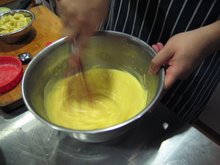


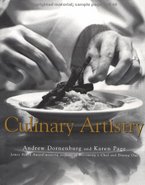





.jpg)
